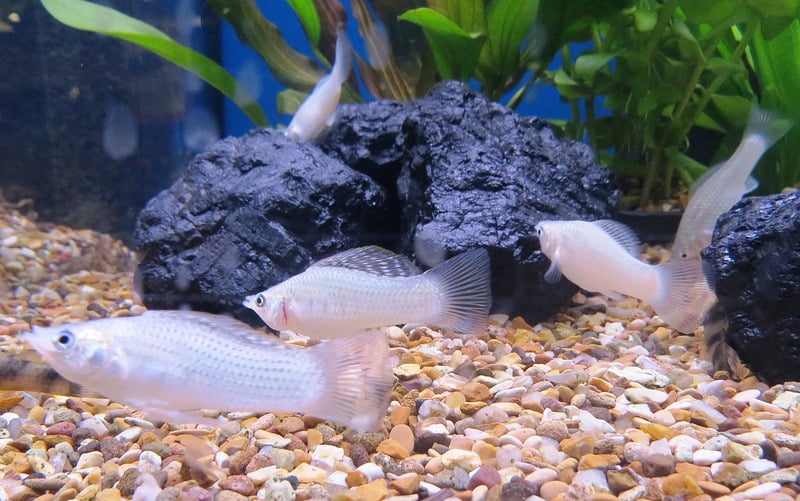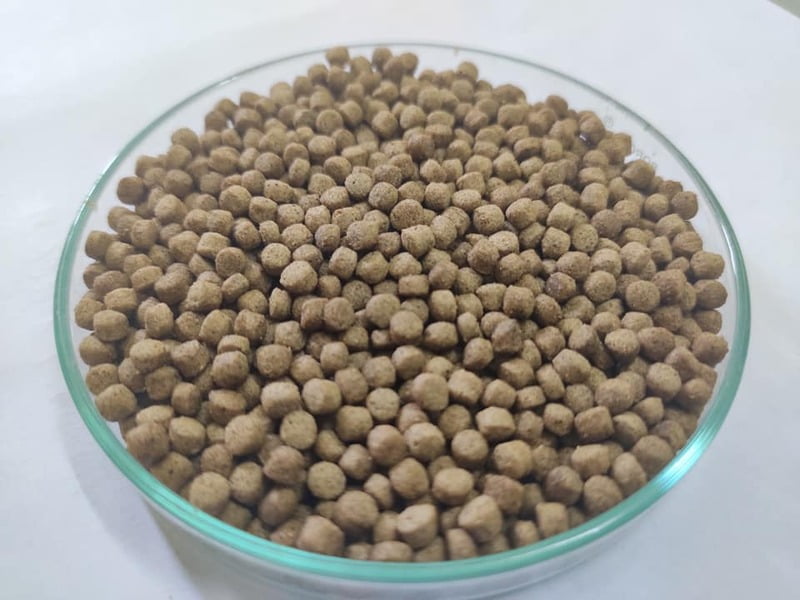The peaceful nature and ease of care of molly fish make them a popular choice for aquariums. A variety of colored molly fish are available, but the most popular is the white molly. Mollies are hardy fish that can adapt to a wide range of water conditions, which is why they are a great choice for both beginning and experienced aquarists.
Related Articles
- Chocolate Molly Fish Facts: Care, Diet And Tank Mates
- Platinum Molly Fish Profile: Care, Food, Breeding, Tank And More!
- Black Molly Fish Male And Female: How To Determine & Important Notices
- Blue Molly Fish: A Rare Hue, 3 Detail Cases & Care Guidelines
- Orange And Black Molly Fish: Gender, Care, Diet, And Tank Condition
- Orange Molly Fish: Why It Is A Top Selection Includes An Unique Case
Molly Fish White: Basic Information
Velvet black has always been considered the classic color variant for the mollies. Nevertheless, breeders always try to create something new and unusual when creating new breeds.
White mollies are born this way. White Sailfin Mollies (Poecilia latipinna) and Giant Sailfin Mollies (Poecilia velifera) are collectively known as the white Sailfin Molly, along with several hybrids. There is no such thing as an albino molly.
Unlike their congeners, white mollies differ only in their body color. As with other decorative species, these are all unpretentious fish that get along well with other decorators.
Viviparous Mollie fish develop their eggs in the womb of the female, and the fry is born already fully developed and ready for independent feeding.
Beginner aquarists can breed their fish with ease due to this feature. Additionally, breeding is a simple process that lets everyone become a breeder and have a chance to get a different color form of fish.
Appearance

A white molly has an elongated and laterally compressed body. Their heads are thin, and their mouths are upper. Black eyes stand out against the white body, which contrasts with the large and round size of the eyes.
Depending on the species, the dorsal fin can be small or well developed. The only differences are its transparency and white spots. In general, the caudal fin resembles a lyre. The female Molly can grow up to 10 cm in length, while the males are much smaller.
White mollies exhibit considerable sexual dimorphism, the anal fin of males transforming into a tubular organ called a gonopodium, while the anal fin of females remains triangular.
Habitat
The white molly is a result of breeding, so it is not found in the wild. The species is endemic to Central America.
Additionally, fresh and slightly salty water are beneficial to fish, as are areas where rivers flow into the ocean (where rivers flow into the ocean). Mollies naturally occur in a wide range of salinities and can withstand very slight increases in salinity.
White mollies are commonly found in home aquariums all over the world. You can find them from special aquarium farms or local aquarium breeders.
How To Take Care Of White Molly Fish
Water
The white molly is a tough fish that can adapt easily to the various conditions of the water. During the indicators change, it is vital not to make sudden changes. In general, Mollie does not like too soft water, and it is best if the soft water is medium-hard.
A proper water tank needs to have 20% of the water replaced once a week. When you want to make tap water safe for mollies, you should add Tetra AquaSafe conditioner to it. It is designed to instantly remove chlorine compounds and heavy metals from the water, making it suitable for them.
Aquarium water parameters should be between 23 and 28 degrees Celsius, a pH of 7.0 to 8.0, and a GH of 10 to 20.
White mollies can withstand a little rise in salt (up to 2-3 g/liter of water). However, keep in mind that this should not be done in shared aquariums since not all species will be able to resist it.
Such suggestions are common, but they are not required because white mollies thrive in freshwater.
Tank Mates
Among the best candidates for a general aquarium are white molly fish because they are peaceful and friendly.
White mollies are recommended to be kept with other fish such as Swordtails, Odessa Barbs, Tiger Barbs, Denison Barbs, Tetras, Rainbowfish, Harlequin Rasboras, and peaceful catfish, including Hypostomus and Corydoras. If you keep your white mollies with large predatory fish like an Oscar, Flowerhorn, or Parrot Cichlid, they can become stressed.
You should not keep white mollies together with other forms of other colors if you wish to maintain a pure line of white mollies even though black and white mollies appear exceptionally stunning together.
Feeding White Mollies

Presented as omnivorous fish, white mollies should consume both plant and animal food. Mollies readily accept any type of food, whether it is live, frozen, or natural.
The disadvantages of these fish are many, including their imbalance, ability to carry infections, etc. Water quality can also quickly degrade when they are present.
As a result, it is recommended to stick to high-quality dry food. These products are rich in vitamins and nutrients and contain a wide range of nutrients.
Since the components are easily digestible, fish waste is less likely to pollute the aquarium. White mollies should be fed twice a day with a tiny bit of the feed and ensure that the fish entirely consume it within a few minutes.
It is also suggested that mollies have a fasting day once a week. They can be helpful on days like these by eating up some algae development in the tank.
Breeding
The offspring of mollies can easily be bred at home. They are viviparous, meaning they do not require specific conditions in order to reproduce.
Small fry will soon appear among small-leaved plants, soil, and decorations if you have a few fish.
You can differentiate the male and female white mollies quite easily. You can tell the difference by looking at the anal fins. A tube-shaped fin (gonopodia) is a male, while a standard-shaped fin (fin) is a female.
Molly whites reach sexual maturity at around a year of age, and females a little earlier. Using the gonopodium, he inserts the sexual products directly into the abdominal cavity of the female after chasing her for some time.
Females at the point of childbirth should be transferred to a special jig or spawning aquarium. The fry has a greater chance of survival because, in a typical aquarium, neighbors and even the mother can consume the fry.
Fry
Fried eggs are apparent as soon as the abdomen swells, the anal fin darkens (not so noticeable on black species), the annulus swells, and the females frequently lie alone in dense vegetation.
A fascinating fact is that male reproductive products can be stored in the female’s body for a long time, gradually fertilizing the eggs. This means that spawning can occur even if only one fish is present in the aquarium.
It usually takes about one month for eggs to develop in a female’s body. Water temperature plays a role in how quickly eggs incubate.
White mollies are fertile – they can produce 50 to 350 fry per female. When they are born, the fry can feed themselves immediately. TetraMin Baby fry feed is an excellent choice for feeding them.
Where To Buy White Molly Fish & Price

There is no one-size-fits-all answer to this question, as the price of white molly varies depending on where you buy it and how much you pay. However, some general tips on where to buy white molly and the prices associated with it include:
Some online retailers sell white molly for around $4/per one. White molly can also be found for sale at fish markets or through fishing supply companies. Some larger supermarkets also sell white molly, but at a slightly lower price.
Here are some online stores you can check and buy:
Video: A White Molly Fish Giving Birth
FAQs
How long do white molly fish live?
An average lifespan is between 3 to 5 years, depending on the individual’s overall health, genetics, diet, etc.
How big do white mollies get?
Full-grown mollies measure between four and four and a half inches long. These fish can be kept in small aquariums since their length is relatively manageable.
What do white molly fish eat?
In addition to algae, these fish love blanched vegetables such as lettuce, spinach, and zucchini. They also like high-protein snacks from time to time. Mollies will accept bloodworms, either live or frozen, as well as daphnia and brine shrimp.
Final Thoughts
In conclusion, white molly fish make excellent aquarium fish because they are hardy, active, and colorful. They can thrive in various water conditions, making them an ideal choice for both beginners and experienced fish keepers. If you are looking for a beautiful, easy-to-care-for fish for your aquarium, be sure to add a few white ones to your tank!
References
https://en.wikipedia.org/wiki/Poecilia_sphenops

Annette M. Chaney is an experienced marine biologist with over 20 years of experience as an aquarist and fishkeeper. She started her first aquarium at a young age, filling it with frogs and goldfish obtained from the ten-cent pet store.
Annette grew up caring for and breeding African Cichlids, which led to a hobby in high school that doubled as a profitable means. Attending Reed College gave her time to solidify herself as an accomplished aquarium caretaker with an eye for sales. After that, from 2009 – 2013, she studied at Roger Williams University – one of the most prestigious universities for Aquaculture and Aquarium in USA. She is the founder of AquariumCircle since 2010.
